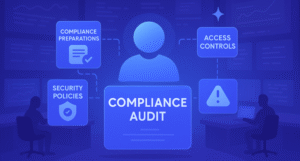If you’re a small or mid-sized business, you may feel unprepared to harness the power of AI. You may feel like you lack training or internal skills in order to pull it off across your departments. You’re not alone. Only 12% of SMEs have actually invested in AI-related staff training.
That’s a mistake business will continue to lose millions over until they can correct it.
Too much time is spent on repetitive, manual tasks that drain productivity and slow down growth. It might be managing cloud technology and infrastructure. Or perhaps it’s handling security monitoring. Still today too many teams find themselves buried in work that doesn’t move their business forward.
This is where AI changes the game.
When integrated into cloud computing, AI can:
- Take over time-consuming processes
- Optimize workflows
- Help manage resources more efficiently
- Reduce costs, including your cloud cost
- Minimize human error
Yes. It really can do all of that for your business.
The result? Your team spends less time on tedious admin work and more time on innovation, strategy, and scaling your business.
Despite the clear advantages, many SMBs are hesitant to make the shift. Who can blame you? You’re unsure about the upfront costs or skeptical of the impact. Or both.
But the ones who have taken the leap are already seeing massive returns. They’re saving time and money.
In this article, we’ll break down exactly why AI in cloud computing isn’t just a nice-to-have but a must-have for any SMB looking to stay competitive. And we’ll show how this all relates to your cloud computing ROI.
Key Takeaways
- By automating repetitive tasks, optimizing processes, and managing resources with AI in cloud computing, SMBs can drastically reduce manual labor, minimize human error, and improve productivity. And all of these lead to significant cost savings.
- Companies like Uniphore, TechstyleOS, and PartnerTap have already leveraged AI tools like Duplocloud to cut development time, improve productivity, and streamline operations. This demonstrates the tangible ROI that SMBs can achieve.
- SMBs can begin their AI journey today by defining a specific use case, developing a strong data strategy, and choosing supportive AI tools.
Cloud Computing ROI: Cost-Savings & Efficiency Gains Through AI Integration
Just look at what AI does in cloud computing: automates tasks, optimizes processes, and helps manage resources. In each section, you can pinpoint exactly where you’re saving money and increasing efficiency.
Task Automation
The automation of repetitive, tedious tasks is perhaps one of the greatest benefits of introducing AI to cloud computing. You might be storing, managing, and analyzing data, testing and developing software, or engaging in some form of communication. No matter the case, automation can be a useful tool. It can make your work faster, more accurate, and more pleasing to your customers.
Here are just some of the tasks you can automate in the cloud:
- Application deployment
- Infrastructure provisioning
- Security management
- Resource scaling
- Decision-making
- Continuous monitoring
- And more
When you automate tasks in cloud computing, you’ll save tons of manual labor hours. Even better, you’ll cut down human errors and improve resource allocation. Let’s face it. There are some things that machines are just better at doing. After all, they don’t get tired, they don’t get emotional, and they don’t get distracted.
So efficiency goes up while costs (including cloud costs) go down.
Process Optimization
Optimizing processes in cloud computing goes hand in hand with task automation. As you automate, you will naturally be optimizing. Optimizing processes in the cloud means analyzing them systematically and targeting areas that can be run more efficiently. You’ll do this in a way that requires less human input. What can you optimize in the cloud?
- Cloud cost management
- Cloud usage
- Managed services
- Resource utilization
- Storage management
- Security measures
- Performance enhancement
AI can help you scale appropriately, continuously monitor security threats, and enable resource efficiency. So you’re not wasting money on overprovisioning or underprovisioning. If you have AI continuously monitoring your systems and constantly seeking areas for cloud optimization, you’ll always be poised to cut costs and improve efficiency.
Resource Management
Finally, resource management is an umbrella over task automation and process optimization. As tasks are automated, your resources are better managed. And as your processes are optimized, your resource allocation will be streamlined.
Resource management with generative AI is possible thanks to predictive analytics and leveraging machine learning algorithms.
Essentially, you design or work with AI systems designed to automate scaling, enhance security, automate tasks, and predict future needs on a continuous basis. And the trade off is that you’ll cut costs and improve efficiency. You’ll be maximizing cloud ROI because you’re almost never using more than you need. No more employing staff for repetitive tasks or worrying about human error..

Understanding Cloud Computing ROI for SMBs
The bottom line is that cloud computing ROI isn’t only a matter of cutting costs. It’s also about adding value to your business. For SMBs, you’ve got to look at every dollar you’re investing. And then you’ve got to translate that into how much time you’re saving and how fast you’re growing. On top of all that, you’ll need to connect these metrics to your customer satisfaction scores.
It is in this massive undertaking that AI shines.
AI in cloud computing increases your ROI because it increases efficiency while delivering financial returns that you can track easily.
To track your ROI, remember to consider both direct savings and indirect value gains:
Direct savings: AI cuts down on your labor costs by automating repetitive tasks. It also lowers your infrastructure costs by scaling your resources. Finally, it reduces the amount of money your company spends on fixing errors late in the development cycle. As just one example, you won’t have to hire more engineers to manage your scaling or security monitoring. Instead, you can trust AI to handle it automatically… at a fraction of the cost.
Indirect value gains: But the real ROI enters the conversation with faster speed-to-market and better decision-making. Because your teams spend less time on manual admin work, they can focus on strategy. And that strategy begins as a cloud strategy. They’ll also be free to innovate and engage your customers. Each of these benefits will increase your revenues.
As a good rule of thumb, SMBs can calculate ROI in three buckets:
- Cost avoidance: This is the money you save by preventing mistakes, downtime, and overprovisioning.
- Operational efficiency: This is the time and labor hours you get back because you automate workflows.
- Growth enablement: This is the revenue you bring in thanks to faster launches, better product quality, and improved customer satisfaction.
When you can frame your cloud computing ROI in this way, you can clearly see that cloud-based AI isn’t just another cost. It’s a cloud investment that will bring in returns across multiple dimensions of your business.
How Microsoft 365 Copilot AI Is Helping Small Businesses
But don’t take our word for it. Microsoft has introduced an AI system it calls Copilot that helps automate tasks, generate content, and offer suggestions to employees of small and medium businesses. The company recently shared a blog post that includes 400 companies it has been able to help through the use of AI integration.
Just a few examples include:
Birlasoft, a software company that deployed Copilot to build a bot that handles 94% of policy-related queries.
HCLTech used Copilot to develop TeamSight, a platform to help accelerate engineering.
LambdaTest integrated Copilot to reduce 30% of its development time.
PGP Glass introduced Copilot to manage repetitive tasks and saw an increase of 30 to 40 minutes per day in productivity.
And that’s just a handful of success stories related to a single AI-powered tool. There are many others, like DuploCloud, designed for specific industries that specialize in specific projects and types of management.
We’ve been able to help several businesses streamline their development processes. This is thanks to our platform that integrates AI to automate at every stage possible.
Kami Vision, just one example, has been able to streamline:
- The creation of new environments
- Automatic deployment and management of Amazon Web Services
- Integrated developer tools for a seamless development pipeline
And we’re still in the very early days of AI and automation in cloud computing.
The future looks bright.
Measuring Cloud ROI & Key Metrics for Cloud-Based AI Solutions
Measuring your organization’s ROI when it comes to introducing AI in cloud computing for your business is critical.
So, how do you do it?
Take a look at the key metrics:
- No more human error: You don’t have to go back to the drawing board again and again during development because an error or vulnerability was caught too late.
- No more useless labor hours: You don’t have to employ staff to continuously monitor the cloud for breaches and potential threats.
- No more manual monitoring: You don’t have to evaluate each step of development for discrepancies.
Even better, as AI continues to learn from its experiences and from your users, it will continue to get smarter. This means your products can get to market faster, and with even fewer hiccups along the way. You can also reduce cloud spend and cloud expenses along the way because you’ll be automating the monitoring of your usage. So you’ll maximize cloud efficiency.
So, practically, you can add up the cost for the number of hours you’d normally employ a staff member to do these tasks. Then, subtract the amount of money you spend on AI-driven cloud computing. Don’t forget to include all the money you spend fixing errors, especially those caught way too far down the development line. Or the money you’ll spend on security experts. Your cloud spending will also drop.
Your ROI is likely going to be shocking alongside your cloud solutions.
Practical Steps for SMBs to Start Their AI Journey
Ready to get started?
Take these steps to be on your way:
1. Define a use case: This will be your guiding tool that helps you clarify your intentions, find direction, and address problems.
2. Define your data strategy: This will be the backbone of your infrastructure. You can choose from among a variety of data types for your AI purposes. As your company grows, your strong, well-defined data strategy will enable your AI solutions to maximize scalability.
3. Identify your tools and methods: Tools like Copilot, GitHub, and DuploCloud will be essential to your cloud service and AI journey as they support each step you take in development, content creation, customer service, and more.
From here, the sky is the limit. You can nail your cloud computing ROI every time.
Sit with your team, discuss your use case, your data strategy, and which tools are right for your business, and you’re ready to go.
Book a demo with DuploCloud today to see if our services might be a good fit for your cloud cost optimization.
FAQs
1. How does AI in cloud computing save money for small and medium businesses?
AI automates repetitive tasks, optimizes cloud resource usage, and reduces human error. All of these lower labor costs, improve operational efficiency, and eliminate costly mistakes or overprovisioning in the cloud.
2. What types of tasks can be automated with AI in the cloud?
Common tasks include application deployment, infrastructure provisioning, security management, resource scaling, continuous monitoring, and even decision-making processes.
3. How do I measure the ROI of integrating AI into cloud computing?
Track key metrics like reduced human error, decreased manual labor hours, faster development cycles, and improved resource efficiency. Compare these savings against the cost of your AI solutions to determine your cloud ROI.
4. What’s the first step for SMBs looking to adopt AI in cloud computing?
Start by defining a clear use case, developing a solid data strategy, and choosing AI tools that fit your business needs. From there, you can scale and integrate AI deeper into your workflows and cloud adoption.



